The Pekin duck. Oh, we’ve all seen the Pekin duck. Many “city people” and other laypeople have hardly seen any duck but the Pekin (and Mallard). They are the duck. The duck of all ducks.
Pekins are also called the American Pekin, White Pekin, or Long Island Duck. They’re the most popular domestic duck breed, numbering tens of millions in the United States. There are more Pekins than all other duck breeds combined.
For those raising ducks for the first time, Pekins are a common entry point. For those who are exploring all the duck breed options, Pekins may seem ordinary, but they’re still worth considering owning. They come with a host of attractive traits. They’re popular for a reason: they can do just about everything. Pekins are unbeatable meat birds, good layers, pretty, friendly, calm, hardy, fertile, easy to find, and just lovely little ducks overall. Whether you’re new to ducks or experienced, whether you’re interested in ducks for eggs, meat, or pets, Pekins are not a breed you can ignore.
Disclosure: This post contains affiliate links. As an Amazon Associate, I earn a commission if you purchase something through a link on this post, at no additional cost to you.
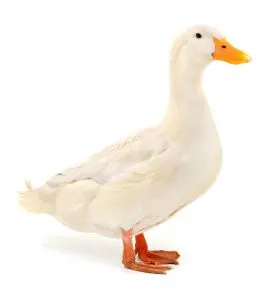
Behold: Pekin duck.
Infographic

Appearance
Pekin ducks have two main traits: big and white.
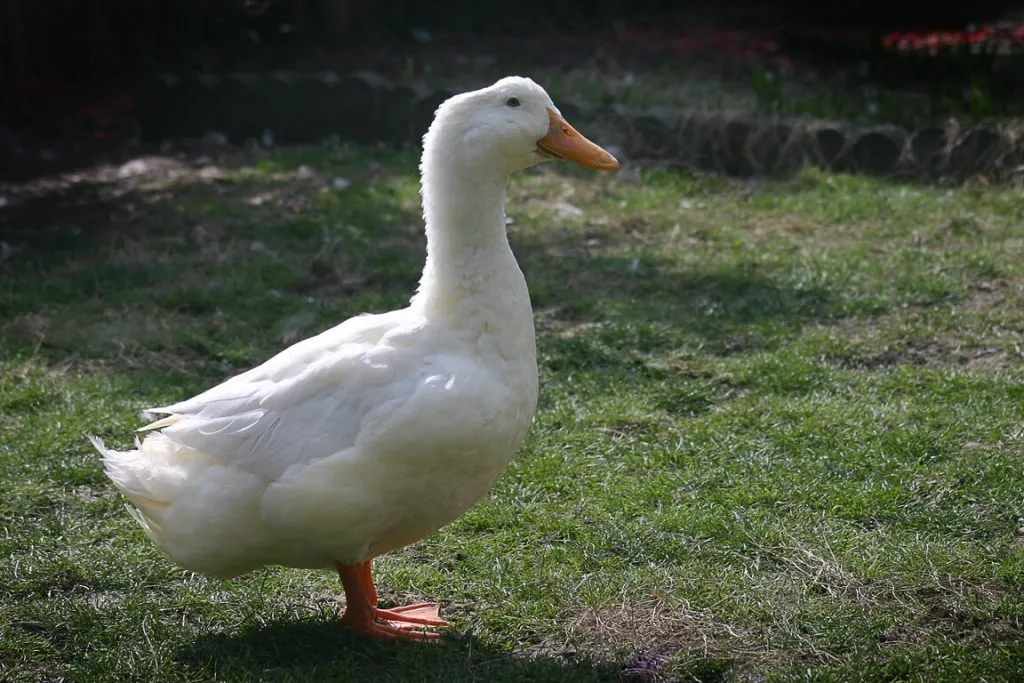
Photo credit: “My boy Flapper” (CC BY-NC-ND 2.0) by tifotter
Color & Plumage
Pekins have yellow-orange bills and orange shanks and feet. Their bills may also have black speckles or splotches, although this is a fault in exhibition birds.
Their plumage is white with a cream or yellow tint—the stronger, the better. Between 1910 and 1930, the British Standard insisted Pekin plumage should possess a canary-like yellow color. However, sunlight bleaches this pigment, so “ideal” coloration is hard to achieve without denying the ducks access to sunlight. Feeding greens, corn, marigold petals, and other yellow feed can enhance the yellow tint. Pekins are the only white duck breed whose feathers are not supposed to be pure white.
View this post on Instagram
In addition, their feathers are extremely fluffy and bushy, more like down than the tight waterproof sheath other ducks often have. This makes Pekins look bigger and chubbier than they actually are.
Pekins don’t come in any other color varieties, only white. Ducklings are bright yellow.
How much do Pekins weigh?
Pekins are classified by the APA as a heavy breed.
- Female Pekins typically weigh around 8-9 lb (3.6-4 kg); male Pekins weigh around 9-10 lb (4-4.5 kg).
- Jumbo Pekins weigh 9-13.5 lb (4-6.1 kg).
- German Pekins (a separate but related breed, the primary type of Pekin found in the UK) tend to be slightly smaller, with females weighing 8 lb (3.6 kg) and males weighing 9 lb (4 kg).
They are around 20 inches (51 cm) tall.
Pekins are fully feathered and weigh 90% of their adult weight by the time they’re only 7 weeks old. However, they don’t reach full maturity until 16-28 weeks.
Conformation
When it comes to conformation, big is the name of the game. American Pekins have a long, broad body, a thick neck, and a large, rounded head. They have a wide, full breast. They are solidly built and have a rectangular body shape from a side view. Their body carriage is 35 to 45 degrees above horizontal, and they have an upturned rump and tail.
Long story short? Pekins are cute, chubby white marshmallows.
Eggs
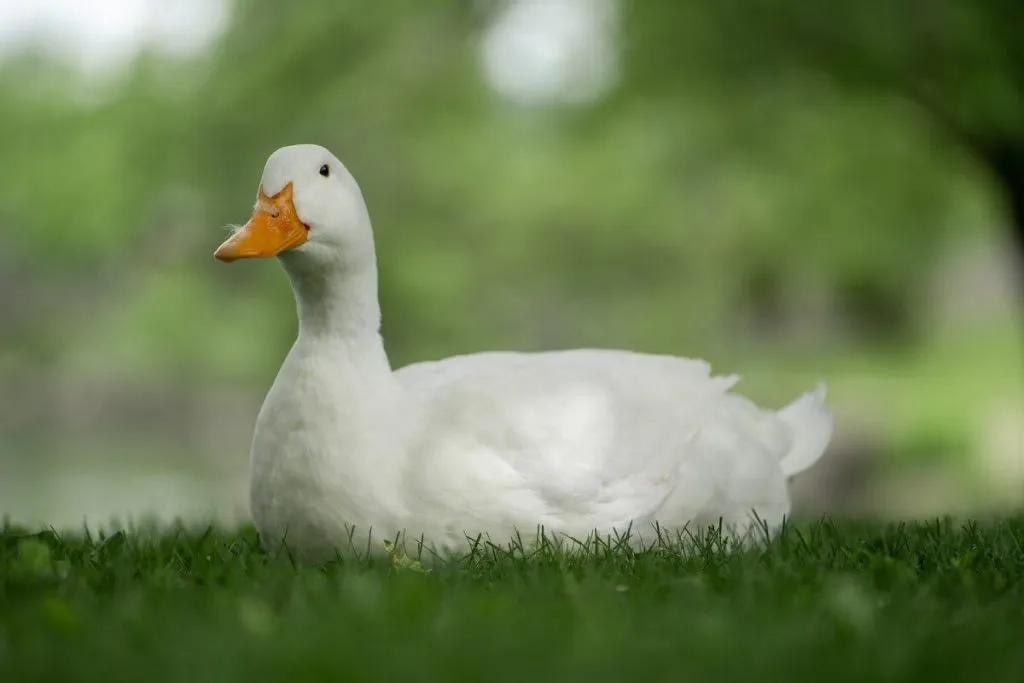
Despite being considered meat birds, many Pekins are good layers. However, there are many, many strains of Pekin ducks, so an individual Pekin may lay as few as 50 or as many as 300 eggs per year.
How many eggs do Pekins lay per year?
- Grimaud Hybrid Pekin: 150-200 eggs a year
- Jumbo Pekin: 140-175 eggs a year
- Cherry Valley Pekin: 200-300 eggs a year
- German Pekin: 50-80, sometimes up to 150 eggs a year
- The average American Pekin likely lays around 125-225 eggs a year.
Pekins in the UK are often German Pekins or similar, and thus lay less than most Pekins in the USA.
A Pekin’s eggs are white, sometimes with a slight yellow tint. They’re extra large, generally weighing 90-100 grams, which is larger than a jumbo chicken egg.
If you’re new to ducks, yes, you can eat duck eggs, and they are just as good as chicken eggs or better. Their taste is similar to chicken eggs, but richer. They are better for baking than chicken eggs, as they are richer and result in lighter, fluffier baked goods.
When do Pekins lay eggs?
Some Pekins, particularly those that are poorer layers, are seasonal layers that primarily lay in spring and summer and don’t lay much if at all in winter. Those that are better layers will likely lay through the winter.
When Pekins start laying also varies a lot, depending on the strain. On average, however, you can probably expect your Pekin to start laying when she’s around 20 weeks (5 months) of age. Some Pekins will start laying as early as 16 weeks (4 months), while others will only start laying at 28 weeks (7 months) or occasionally even 32 weeks (8 months).
If you’ve just gotten Pekins, or if yours are young, they may not start laying until next spring. Often, especially if a duck reaches laying age during fall or winter, she’ll only start laying during her first spring.
Meat
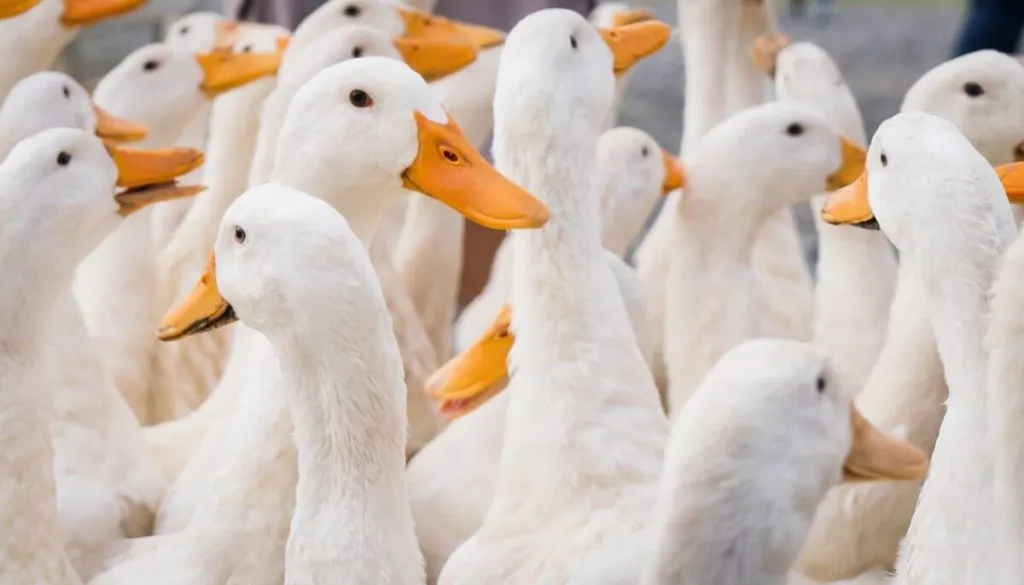
Commercially, American Pekins are used almost exclusively for meat, and over 95% of duck meat produced in the U.S. comes from Pekins.
Pekin ducks are the ideal duck breed for meat because they:
- Are large
- Grow more quickly than any other duck breed
- Convert food to meat more efficiently than any other duck breed
- Have white feathers
Pekin growth rate
At six weeks, they can weigh 6-7 lb; at seven weeks, they can weigh around 8 lb. Dave Holderread says they can achieve as much as 8.5 lb in eight weeks.
Jumbo Pekins grow slower, but attain larger weights in the end. They weigh 9-11 lb at 12 weeks and can weigh up to 13.5 lbs as adults.
Pekins are usually slaughtered at 6-8 weeks of age. At 8 weeks, they usually dress out at 5 lb or more.
Feed conversion rate
Pekins have a phenomenal feed conversion rate: generally anywhere from 2.5 to 3. In other words, they eat 2.5 to 3 pounds of feed for every pound of live weight gain. Some sources list their average feed conversion rate at 2.6. Some strains of Pekins can attain FCRs of as low as 1.9.
For comparison, the hybrid Cornish Cross chicken can have a feed conversion rate of 2 or possibly better, in optimal conditions. Pastured Cornish Cross will often have an FCR of around 3.5. They can weigh 6lb at 6 weeks. Many heritage meat chickens have a FCR of 5 or worse.
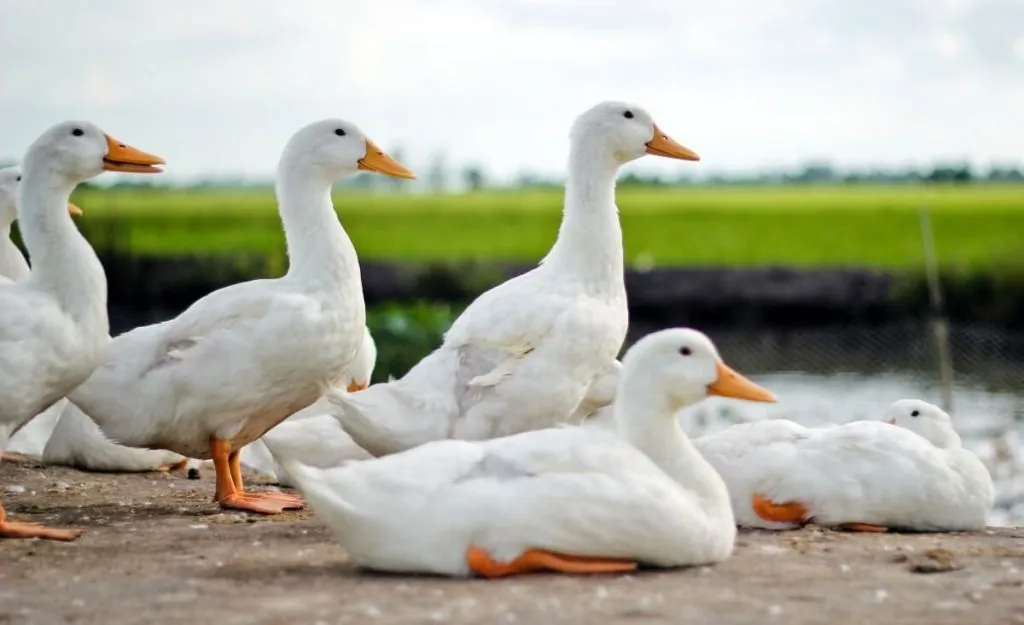
Photo credit: “Ducks” (CC BY-ND 2.0) by Minhimalism
If you want to raise ducks for meat, Pekins are likely the best option. No other duck breeds compare to them. Cayugas, Rouens, and Aylesburies are frequently used for meat, but they don’t hold a candle to the Pekin. Muscovies are their closest competitors, but they grow much slower.
Another reason Pekins are the preferred breed for meat is their white feathers, which make for a more attractive finished carcass. The white pin feathers don’t show up on their skin.
Pekin meat is fattier than that of chickens or Muscovy ducks. It has lighter flesh and a milder flavor than Muscovy, but it’s still considered dark meat.
Broodiness and Mothering Ability
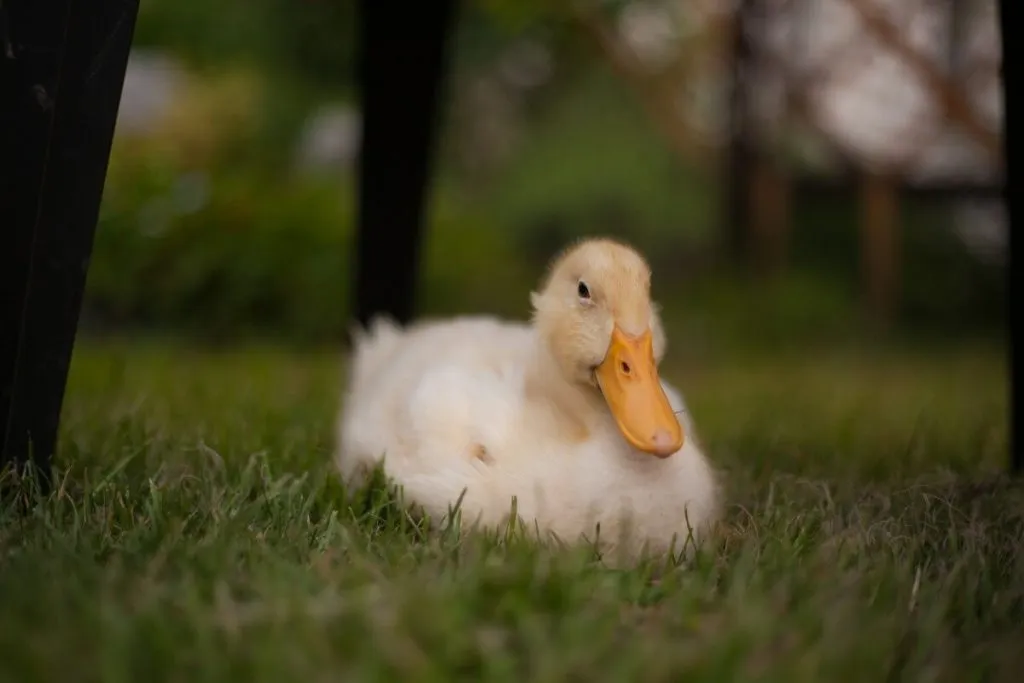
Pekins are famously bad broodies and mothers. They rarely, if ever, go broody and sit on their eggs. Occasional individuals will sit, but even those may be undependable mothers. If you want to hatch Pekin ducklings, you may need an incubator or a broody of a different breed.
Flying
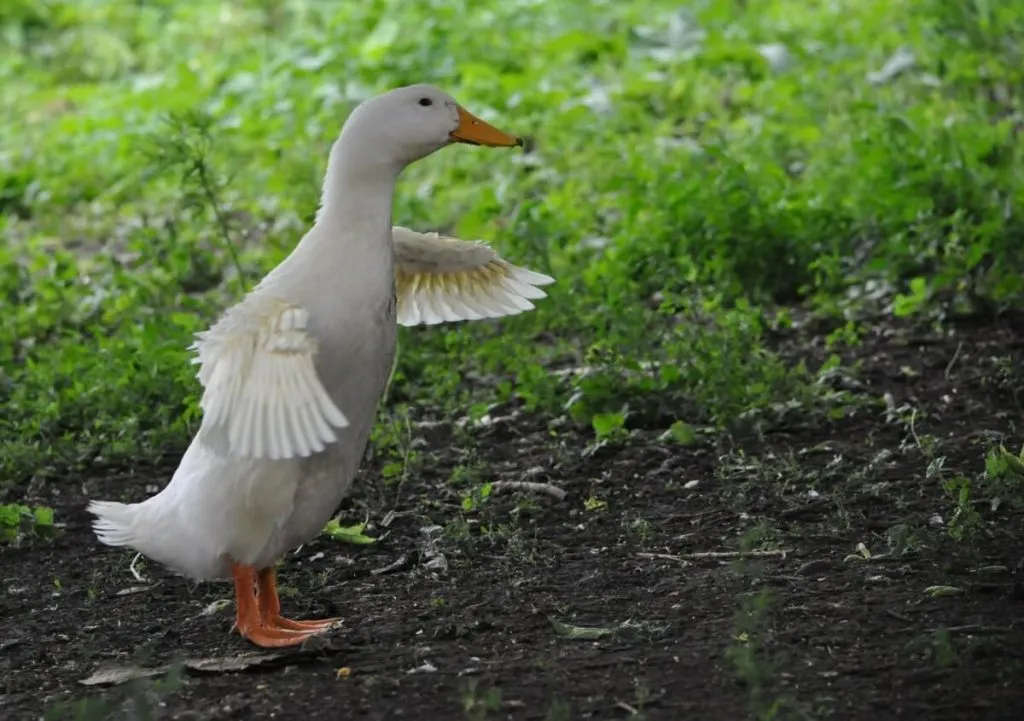
Pekin ducks cannot fly. Most domestic ducks have lost their ability to fly over generations of breeding for other traits like egg laying and size. Their wings are just too small to lift their large bodies.
Some smaller individual Pekin ducks may be able to jump and flap strongly enough to fly short distances or perhaps jump over a four-foot fence.
However, most Pekins are completely flightless. They won’t be able to get more than a few inches off the ground.
Any “Pekin” that can seriously fly is not a purebred Pekin. It might be a White Mallard, Call, Pekin cross, or perhaps a Muscovy.
Pekin ducks do not have a desire to migrate and will not try to fly away.
Since their flying abilities are usually nonexistent or very limited, you probably do not have to clip your Pekin’s wings. A 3-foot fence, or even a 2-foot fence, will contain most Pekins.
Noise
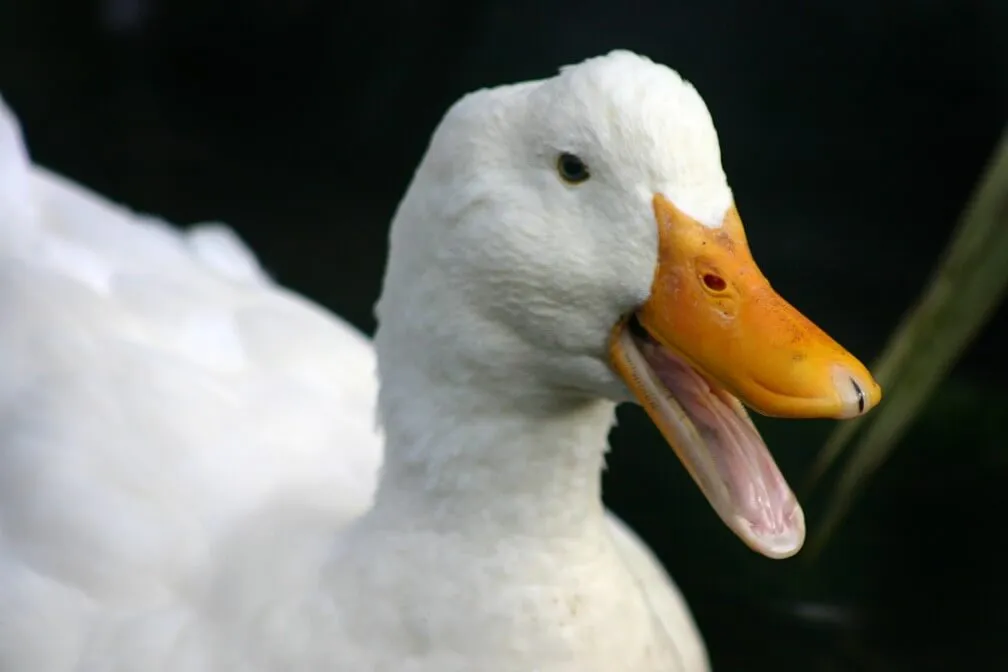
Photo credit: “Quack!” (CC BY-NC-ND 2.0) by tifotter
Pekin ducks can be noisy. They are often considered one of the noisiest duck breeds.
But this depends on the temperament of the individual ducks. Some people with multi-breed flocks say their Pekins are the quietest, others say they’re average, and others say they’re the loudest.
It’s hard to measure which duck breeds are louder or quieter, partly because it varies so much and partly because it’s not easy to measure.
All ducks quack frequently. Whether you find quacking “noisy” depends on you.
Male Pekins are much quieter, since they don’t make the crisp “quack” females make.
Temperament

Pekins are calm and extremely friendly, probably one of the friendliest of all duck breeds. Their docile temperament makes them an ideal breed for pets.
However, avoid getting a Jumbo Pekin as a pet. These birds are so large and heavy they can’t live comfortable adult lives. And their lives are awfully short anyway.
Despite being one of the heaviest duck breeds, Pekins are quite active and are very good foragers.
Pekins are also very hardy. They can live in nearly any climate with few problems. They’re resilient and don’t get sick easily.
Lifespan
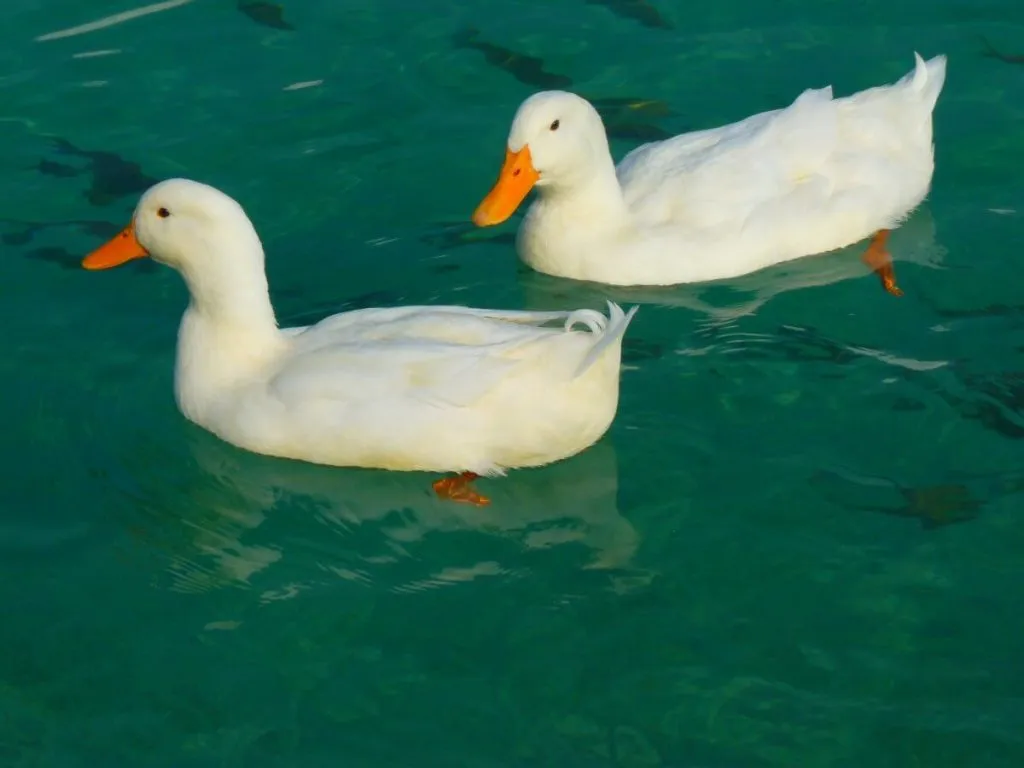
- A Pekin’s lifespan is typically 5-10 years.
- The average Pekin probably lives around 7 years.
- Healthy individual Pekins that are given good care may be able to live up to 10-15 years.
- Jumbo Pekins have particularly short lifespans of around 1-5 years, often dying of heart failure.
In general, Pekins have short lifespans compared to other duck breeds. However, since there are so many different strains of Pekins, with some being healthier and longer-lived than others, there’s a lot of variation.
Males are more likely to live longer than females, due to the likelihood of females having reproductive issues such as egg binding. Since many Pekins are bred for meat and not longevity, they’re prone to having laying issues.
Jumbo Pekin
View this post on Instagram
“Jumbo Pekin” is loosely defined, but it more or less means a strain of Pekin that is larger than the average Pekin. Jumbo Pekins are bred for sheer size and are the biggest Pekins there are. They don’t have the conformation necessary for a show bird, so they’re solely for meat.
They are approximately 15-18% larger than a standard Pekin. In 12 weeks, males can reach 11 lb or more and females can reach 9.5 lb or more. As adults, Jumbo Pekins weigh around 9-13.5 lb.
They lay 140-175 eggs a year.
Jumbo Pekins are not a good choice for pets or layers, since their legs are not built to carry their weight (similar to the Cornish Cross chicken). They are extremely prone to leg and joint issues and many individuals will become lame or crippled within a few years. They are also prone to heart failure and often only live 1-5 years.
If you do have a Jumbo Pekin and want to make sure it lives the happiest life possible, here are three tips:
- Feed it plenty of supplementary niacin, especially while it’s a duckling, to help its legs grow strong.
- Do not feed a Jumbo Pekin free-choice. They must be put on a restricted diet.
- Jumbo Pekins must have access to deep swimming water to take the pressure off their legs.
Grimaud Hybrid Pekin
The Grimaud Hybrid Pekin, created by French breeder Grimaud Frères, is a popular commercial meat bird with fast growth, an improved feed conversion rate, and good laying potential.
It is a cross between two strains of Pekin: a fast-growing male from their GL50 strain and a female with high egg production from their GL30 strain. Grimaud Frères calls this hybrid cross the “Star 53.” Although the birds are purebred Pekins, the parents come from separate genetic lines and thus the offspring have hybrid vigor.
According to their website, their STAR 53 Medium reaches 7.5 lb in 6 weeks, 8.86 lb in 7 weeks, and 9.8 lb in 8 weeks. Their STAR 53 Heavy reaches 7.7 lb in 6 weeks, 9 lb in 7 weeks, and 10 lb in 8 weeks.
The STAR 53 Medium has an FCR of 1.87 at 6 weeks, 2.09 at 7 weeks, and 2.48 at 8 weeks. The Star 53 Heavy has an FCR of 1.88 at 6 weeks, 2.11 at 7 weeks, and 2.52 at 8 weeks.
View this post on Instagram
The ducks in the video above are between three and four weeks old.
Metzer Farms sells the Grimaud Hybrid Pekin and says their birds reach 8.1 lbs in 7 weeks. The dressed weight is 5.26 lb and breast filet percentage is around 25%.
They lay around 150-200 eggs a year.
Other than these improvements, the Grimaud is similar to a normal Pekin.
Cherry Valley Ducks
Cherry Valley ducks are not a breed of duck, but rather another commercial strain of Pekin ducks. They were created by a British company, Cherry Valley Farms, and have become the predominant choice for commercial meat duck farmers.
Cherry Valley produces two variants: SM3 Medium and SM3 Heavy. SM3 Medium reaches 7.5 lb in 6 weeks, and SM3 Heavy reaches 7.7 lb in 6 weeks. At this age, SM3 Medium has an FCR of 1.92 while the SM3 Heavy has an FCR of 1.88.
One feature of the Cherry Valley Pekin is their incredible laying potential: 200-300 eggs a year. Thus, they’re one of the best possible dual-purpose ducks.
View this post on Instagram
View this post on Instagram
German Pekin
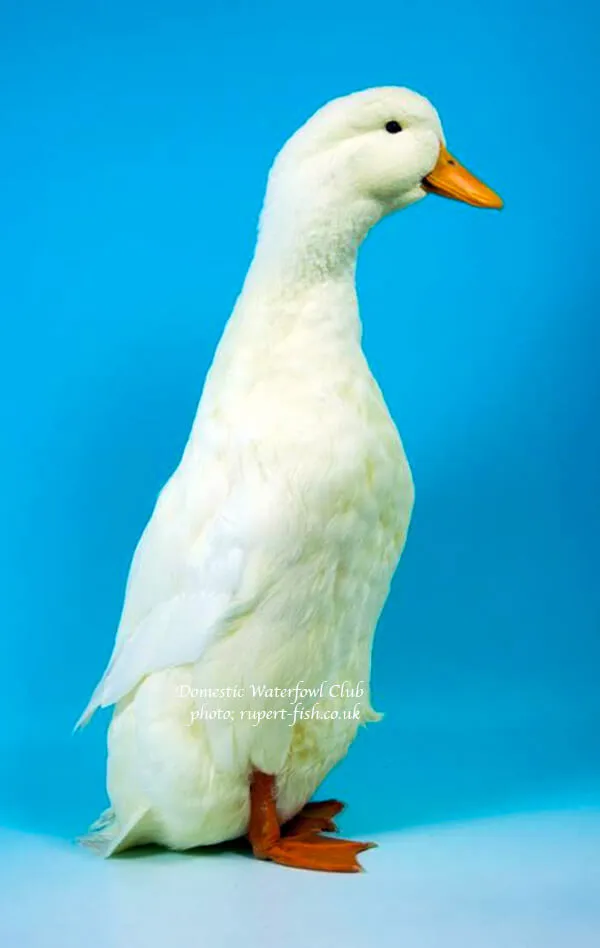
Image used with permission from The Domestic Waterfowl Club of Great Britain.
Pekins have split into two breeds: the American Pekin and the German Pekin. Despite both originating from the same Chinese stock, they are now completely separate breeds. However, there is some confusion, because in the United States, “Pekin” generally refers to the American Pekin, but in the UK and Europe, “Pekins” are usually German Pekins. Most Pekins in the UK today are primarily derived from German Pekins imported into the UK around 1970.
View this post on Instagram
The German Pekin is essentially a Pekin with a Runner-like or penguin-like stance. Conformation is where German Pekins differ most from American Pekins. They have a nearly vertical body carriage, broad shoulders, wide breasts, short necks, chubby heads, and short bills. Due to their short, thick necks, they cannot turn their head back and rest it in their back feathers to sleep. Rather, they have to let their head rest on the ground, as if they were dead. This can cause their eyes to weep.
View this post on Instagram
German Pekins are critically endangered and are on the Rare Breeds Survival Trust (RBST) watchlist.
German Pekins lay less and weigh less than their American counterparts.
Many lay 50-80 eggs a year, others lay up to 150. Eggs weigh 70-80 grams.
Drakes weigh approximately 9 lb (4.1 kg) and ducks weigh approximately 8 lb (3.6 kg). They were originally bred for meat, but today, they’re primarily an exhibition breed. However, they have been influential in contributing to the creation of commercial meat birds.
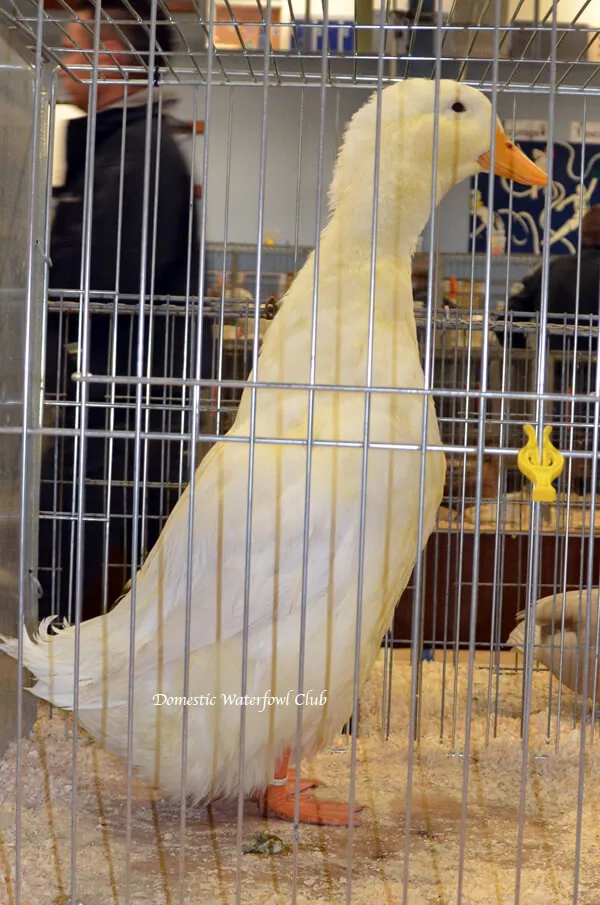
Image used with permission from The Domestic Waterfowl Club of Great Britain.
Pekin vs. Aylesbury
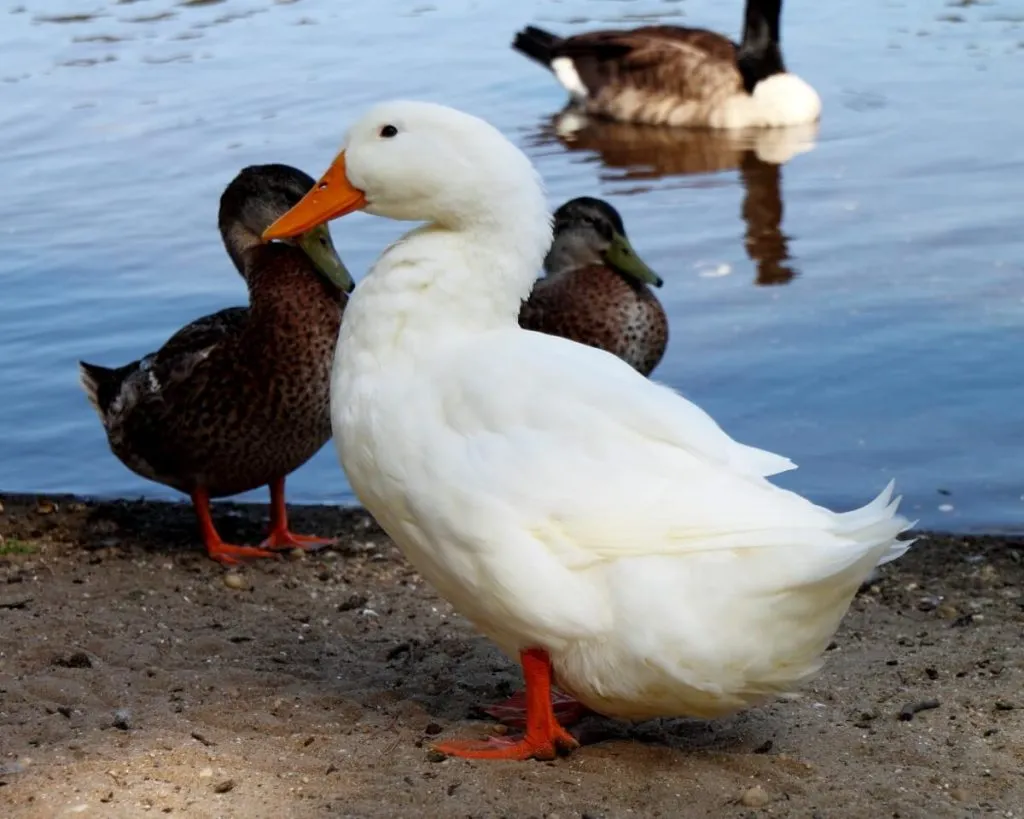
Pekin. Photo credit: “Long Island Pekin Duck” (CC BY-ND 2.0) by Mr.TinDC
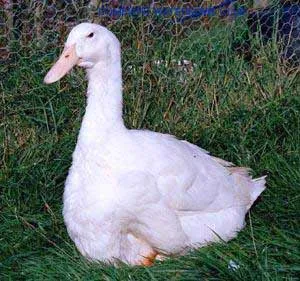
Aylesbury. Image used with permission from The Domestic Waterfowl Club of Great Britain.
Pekins are not the only big white duck breed. The Aylesbury is also big and white, but it’s a completely separate breed. It originated in Aylesbury, England. Aylesbury ducks are much rarer than Pekins, being critically endangered.
The primary difference between Aylesbury and Pekin ducks is that Aylesbury ducks have pink bills. If a duck is claimed to be an Aylesbury but has an orange or orangish bill, it is not a purebred Aylesbury.
Some commercial Pekins do have pink or pinkish bills (in particular, young Pekins and female Pekins that are laying a lot), although this is probably because Aylesburies were likely used in the creation of commercial meat Pekins, such as Cherry Valley Pekins. Since Aylesbury and Pekin ducks are so commonly confused, they’re also frequently bred with each other. Thus, many Pekin ducks are not truly purebred and are actually a Pekin/Aylesbury cross or mix.
Actually, the original American Pekin may have been created by crossing Aylesbury ducks with Chinese Pekins, so perhaps what we know as the Pekin today is partially derived from the Aylesbury after all. Even so, the modern Pekin is supposed to be entirely independent from the Aylesbury and is supposed to have an orange bill.
Pekin duck vs. Peking duck
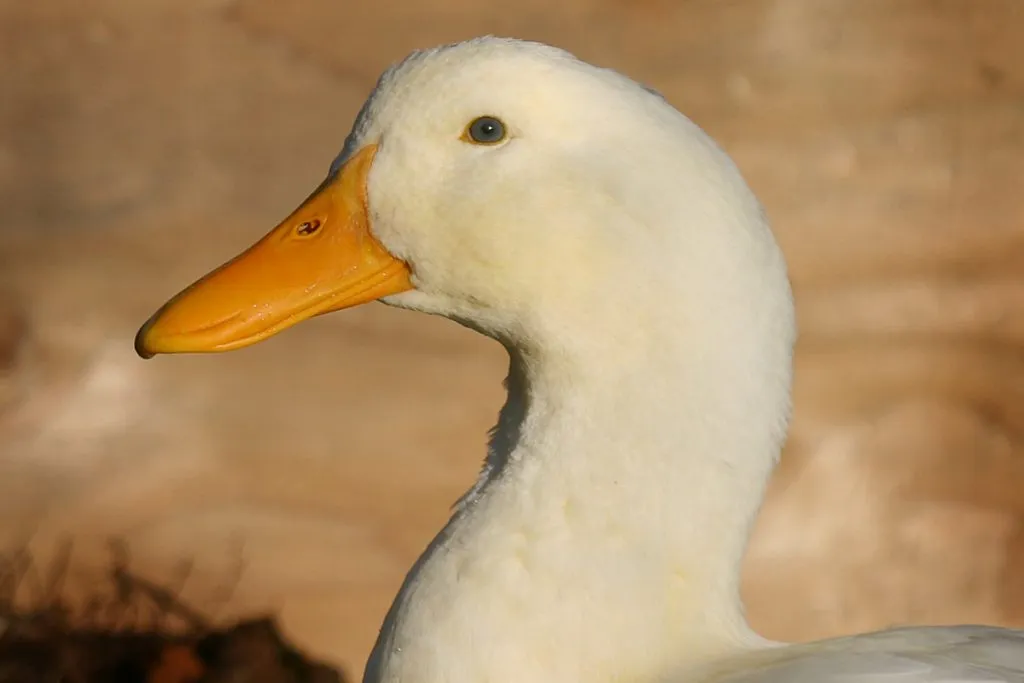
Pekin duck. Image credit: “Flapper in Sunlight” (CC BY-NC-ND 2.0) by tifotter
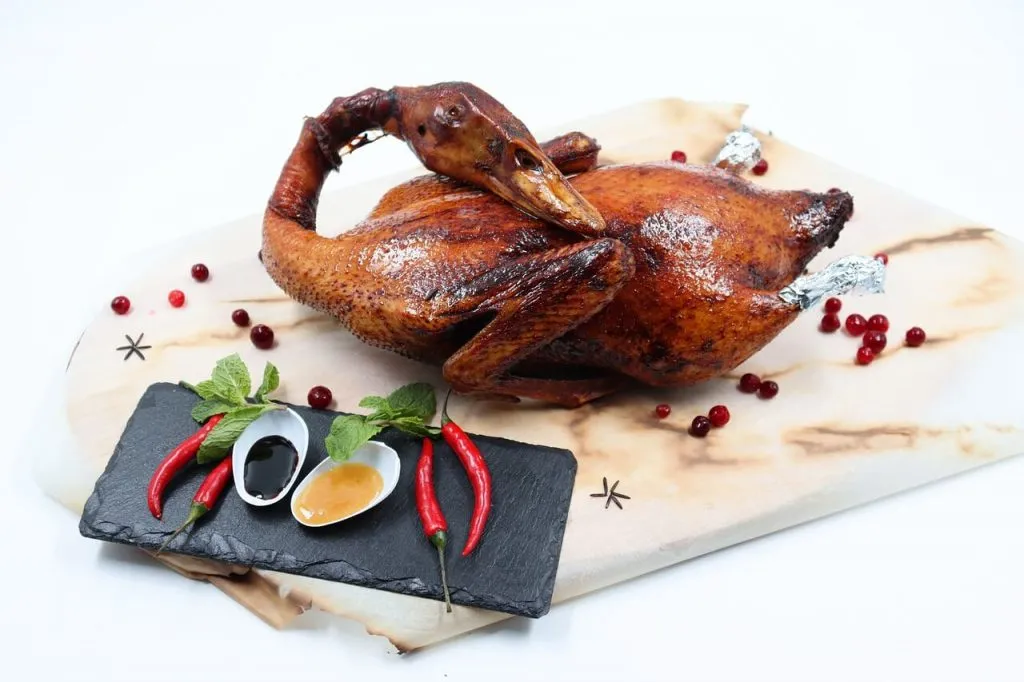
Peking duck
“Peking,” in this context, is an incorrect spelling. “Pekin duck” refers to the breed and “Peking duck” refers to a dish made with duck meat—usually, but not always, from force-fed Pekin ducks.
There’s another reason for this common misspelling. Pekin ducks were bred in China for hundreds of years, but in 1872, some ducks that had hatched in Peking (now known as Beijing) were brought to the USA and UK. Thus, Pekin ducks were commonly thought to have come from Peking.
Whatever the case, if you’re talking about actual live ducks, they’re Pekins, not Pekings.
History

It’s uncertain when the Pekin duck was created, but probably more than 4500 years ago, before 2500 BC. Either way, at some point, the Chinese domesticated the Mallard. Careful selective breeding led to several domestic duck breeds, including a duck they called the “shi-chin-ya-tze,” or “ten-pound duck.”
In New York in 1870, a Chinese student, Mr. Chan Laisun, spoke about this duck.
A letter written by James E. Palmer, which was published in the September 1874 issue of The Poultry World, explains how this duck then arrived in the United States.
Around 1873, in Peking, China (now called Beijing), a Mr. McGrath saw these “ten-pound ducks” and hatched fifteen eggs under a chicken. He sent these fifteen ducks to New York with James Palmer on a clipper ship. After the 124-day voyage, nine ducks (six hens and three drakes) landed in New York City on March 13, 1873. Half of these were to be Mr. Palmer’s, while the other half were sent to the McGrath farm. These were eaten before arriving at their farm, but Mr. Palmer kept the remaining four ducks, which became the foundation of the modern American Pekin, although more were imported from China later.
In 1874, Pekins were entered into the American Poultry Association’s first edition of the Standard of Perfection.
Pekins rapidly gained popularity and were soon the number one meat duck in the United States. Eastern Long Island, with its duck-friendly sandy soils and tidal ponds, became the mother lode of Pekin ducks. By 1900, there were thirty duck farms on Long Island; by 1940, there were ninety. In the 1960s, Long Island was producing 7.5 million ducks a year. However, today, only one farm remains: Crescent Duck Farm in Aquebogue.
German Pekin history
Around the same time as Mr. McGrath sent his Chinese Pekins to the USA, in 1872, a man named Walter Steward also imported some Chinese Pekins into the UK. Some of these were then sent to Germany. Meanwhile, the Dutch East India shipping company also brought some ducks with an upright carriage from Japan to Germany. These white, upright “Penguin ducks” were then crossed with the Chinese Pekins. The result, of course, was the German Pekin, which was standardized in the UK in 1901.
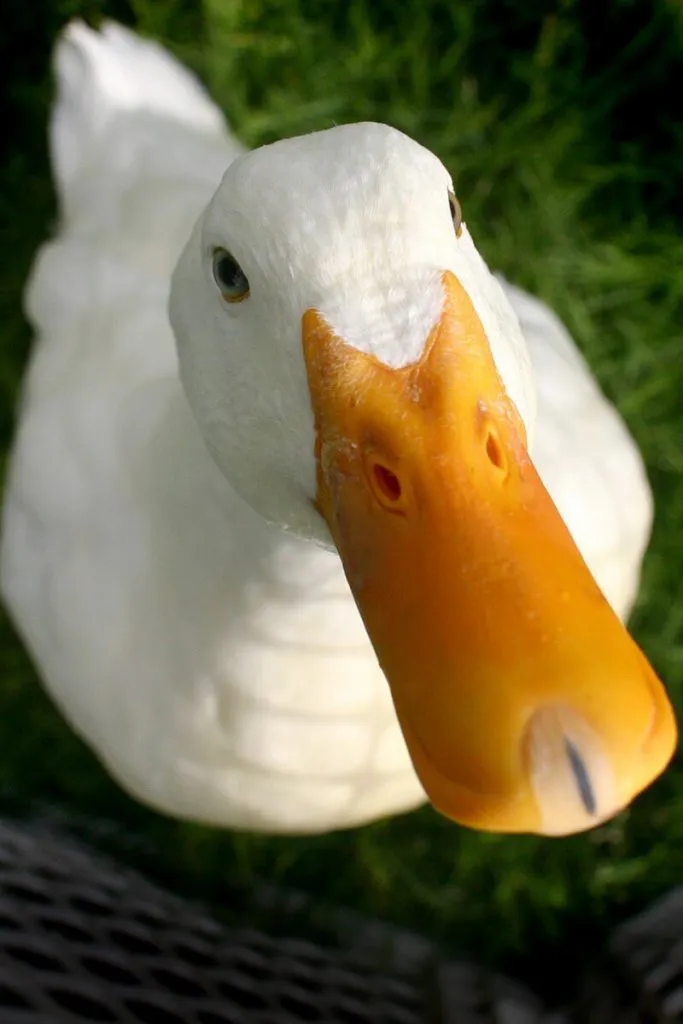
Isn’t he cute? Photo credit: “Up?” (CC BY-NC-ND 2.0) by tifotter
Leave a comment
Your email address will not be published.